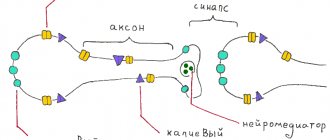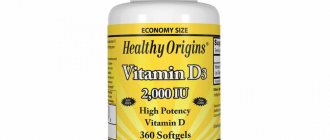What is “excess vitamin D”?
Vitamin D performs many important functions in the body. Excess vitamin D means its content in the blood is much higher than normal, and with a severe overdose, a toxic effect appears.
Norm of 25-OH vitamin D:
| Age | Normal concentration, ng/ml | Toxic effect, ng/ml |
| Infant (up to 1 year) | 15-20 | 50-70 |
| 1-18 years | 20-50 (according to other sources - 30-60) | more than 100 |
| 18 and older | 20-50 (according to other sources - 30-60) | more than 150 |
In adults, when vitamin D is detected in the blood less than 20 ng/ml, they speak of a deficiency of vitamin D. What about excess, or hypervitaminosis, of vitamin D?
With excess it is a little more complicated: laboratories indicate the reference value for adults - up to 100 ng/ml, and the recommended concentration - up to 60 ng/ml. This means that a result, for example, 80 ng/ml is interpreted as an excess, but may not require correction.
Higher values, for example, 100 ng/ml, already create a risk of toxic effects (depending on gender, age, body weight, pregnancy) and require certain measures, which will be discussed below.
Sources of Vitamin D
Vitamin D was discovered about 100 years ago during the search for foods needed to combat deficiencies in calcium and phosphorus in bones and teeth. The benefits of taking fish oil, which contains large amounts of vitamin A, have been proven. However, when this vitamin was neutralized, fish oil retained its properties, which led researchers to the conclusion that it also contains other vital substances. Subsequently, the discovered vitamin received the name of the fourth letter of the Latin alphabet - D. But fish in sufficient quantities was not available everywhere, and organizing the industrial production of fish oil took time. Therefore, the research continued. It was soon discovered that the beneficial properties of certain types of food are enhanced by irradiation with ultraviolet rays. Further, it was possible to prove that vitamin D can be synthesized by living cells under the influence of sunlight.
The second wave of vitamin D research began in the 1980s. Nowadays, experts primarily name fatty fish and dairy products, as well as animal by-products as its food sources [1].
| Food | Vitamin D3 content, IU/100g |
| Cod liver | 5000–8000 |
| Herring | 294–1678 |
| Butter | 52 |
| Egg yolk | 20 ME in 1 piece. |
| Sour cream | 50 |
| Cheese | 44 |
| Beef liver | 15–45 |
If you are intolerant to the protein contained in cow's milk, dairy products made from goat's milk can be a source of vitamin D. They are especially indicated for women during pregnancy and breastfeeding [2]. Quiz: Find out how much vitamin D you get from food.
What causes excess vitamin D?
Hypervitaminosis develops when there is an excessive intake of the vitamin. For example, if you eat a large amount of cod liver at once or eat it for a long time, you can get hypervitaminosis D or A. But more often they occur when taking high doses of synthetic vitamins, for example, in the form of dietary supplements.
This does not mean that dietary supplements should not be taken; it is important to observe the measure. This is especially true for American vitamin supplements, because... In the USA there is a fashion for high dosages of vitamins. Such drugs should be taken in a course, then take a break.
Learn more about vitamin D deficiency
The consequences of this condition lead to serious problems - the development of various pathologies of organs and systems. Main problems:
- immunity suffers;
- there is a metabolic disorder;
- malfunctions may occur in the functioning of organs such as the thyroid, parathyroid, pancreas, adrenal glands, kidneys, lungs, heart, intestines, stomach, pituitary gland, hypothalamus, etc.;
- possible complications during pregnancy;
- menstrual irregularities may occur;
- changes begin in bone tissue, which leads to osteomalacia (leaching of minerals from the bones), and then to osteoporosis, which is fraught with fractures and injuries;
- deformation of posture, weakness and muscle pain occurs;
- problems with the ovaries and uterus (endometriosis, fibroids, etc.);
- a hormonal imbalance occurs: the production of testosterone and estrogen may increase, which leads to early menopause;
- the condition of the skin deteriorates (vitamin D is involved in the process of renewal of skin cells), hair, teeth (caries), manifestations of skin diseases may occur;
- excess weight gain occurs;
- there is a feeling of anxiety, insomnia, depression;
- chronic fatigue and headaches are felt;
- hypertension, diabetes, arthritis, multiple sclerosis may occur;
- ARVI and acute respiratory infections become frequent.
Test: Check if you are at risk of vitamin D deficiency.
What happens from excess vitamin D?
The best treatment for any hyper- and hypovitaminosis is prevention. In order to avoid going to doctors and always be healthy, it is important to follow the rules of rational nutrition, the study of which is nutritional science.
But what to do if excess vitamin D does occur? First of all, it needs to be recognized, and this is not so easy, given that the symptoms of hypervitaminosis are often nonspecific.
In the case of vitamin D, toxicity occurs not so much from the vitamin itself as from hypercalcemia, and the severity of the condition may not correlate with the level of vitamin D in the blood. Therefore, they focus on clinical symptoms and the concentration of ionized calcium in a blood test.
Excess vitamin D: symptoms
In case of acute intoxication:
- Petechiae (pinpoint hemorrhages) are small red dots on the skin that do not rise above its surface;
- Bleeding gums, nosebleeds;
- General malaise, weakness, fatigue, nausea;
- Digestive disorders: loss of appetite, vomiting, diarrhea or persistent constipation;
- Losing weight for no apparent reason;
- Insomnia, irritability;
- Increased blood pressure;
- Slow or increased heart rate;
- Increased temperature (usually low-grade fever - up to 37.5);
- Muscle spasms, cramps.
At later stages (if the person does not seek help in time):
- Polyuria - frequent and copious urination, often combined with thirst;
- Pain when urinating, renal colic;
- Abdominal pain, especially on the right, in the liver area;
- Shortness of breath, cough;
- Hematomas (bruises) that occur even with very weak impact.
Demo lessons on the program “Nutriciology”
Get access
Excess vitamin D in adults and adolescents
Vitamin D tends to accumulate in the body, and hypervitaminosis D usually develops slowly in adults. Long-term (more than 6-8 months) use of moderate doses can have consequences in the form of chronic intoxication - to prevent them, it is important to regularly donate blood for vitamin D.
Chronic vitamin D intoxication occurs:
- Deposition of calcium in blood vessels in the form of plaques;
- Bleeding caused by fragility of blood vessels due to their calcification (internal bleeding is especially dangerous);
- Development of trophic ulcers due to impaired blood supply;
- High risk of heart attacks and strokes;
- Calcium deposition inside joints - development of arthritis;
- Liver dysfunction (since vitamin D is stored there);
- Formation of stones in the gall bladder, kidneys and bladder.
Excess vitamin D in infants and young children
In children of the first year of life, excess vitamin D can occur in several ways:
- Overdose;
- Use of vitamin D in moderate doses if the child is individually highly sensitive to it;
- Excessive intake of vitamin D through breast milk (mother takes vitamins while breastfeeding);
- Hypervitaminosis during pregnancy.
An overdose can occur when taking a large dose of vitamin D at once (therefore, all medications should be kept out of the reach of children) or over a short period of time.
If a child has excess vitamin D, it develops faster (sometimes in a few days), and is more acute and severe than in an adult. With hypervitaminosis D, brain symptoms predominate::
- Sleep disturbance, irritability, moodiness, crying;
- Weakness, dizziness, headaches.
There are also pains in the body of various localizations and cramps. Kidney and liver failure develop earlier, and the lungs are affected. Therefore, at the first symptoms of a child’s illness, you should consult a doctor.
How to reduce vitamin D?
Treatment of hypervitaminosis D is usually carried out in a hospital; therapy is prescribed by a doctor depending on the severity of intoxication.
Basic principles of treatment:
- Forcing diuresis: drinking plenty of fluids, medications (furosemide), intravenous infusion (droppers with saline, glucose);
- Hemodialysis on the first day of poisoning;
- A diet high in potassium (as diuresis increases) and low in calcium;
- Painkillers for relief;
- Hormone therapy: prednisolone, insulin (reduce calcium absorption from the intestines), calcitonin.
Vitamin D intoxication is extremely dangerous. Therefore, it is best to be careful when taking vitamins and remember that too much is just as bad as too little.
The benefits of vitamin D and why you need it
Calciferol is considered a women's health vitamin. Indeed, it is important for women. After all, its consumption, like other vitamins in general, is much higher than in the body of men. This is due to the characteristics of the female body and its functions: the menstrual cycle, pregnancy, childbirth, breastfeeding, menopause. Therefore, at different periods of life, the need for D3 and D2 may increase. But the main thing is that women need to maintain an adequate amount of calciferol, avoiding its shortage or excess.
Thus, vitamin D is essential because it:
- Responsible for the level in the blood of minerals such as calcium and phosphorus, which contribute to the preservation and strengthening of musculoskeletal tissue (bones, joints, muscles, teeth).
- Important for the musculoskeletal system, including correct posture, which is formed before the age of 20.
- Controls the functioning of the immune, cardiovascular, endocrine, hormonal, and nervous systems. In particular, it supports the level of innate immunity; acts as a hormone (D-hormone) that regulates carbohydrate metabolism, that is, it is directly related to weight loss issues. This means it is needed for proper metabolism and maintaining optimal body weight.
- Regulates more than 200 genes.
- It has anti-inflammatory, antitumor, immunomodulatory effectiveness, slows down the aging process, and fills with energy.
- Promotes conception, maintenance of pregnancy and normal gestation; it is extremely necessary during pregnancy, as it affects the formation of the immunity of the fetus and its bone tissue.
- Restores a woman’s body after childbirth, corrects the condition of PMS.
- Good for vision, concentration and memory.
How to find out your vitamin D level?
You can get information about how saturated your body is with vitamin D by doing a blood test. Typically, this laboratory test is carried out if osteoporosis is suspected, during pregnancy, if the woman spends very little time in the sun, lives in the northern regions, has refused food of animal origin, has chronic diseases or hereditary disorders of the metabolism of this vitamin.
Vitamin D correction
Taking D3 is the prevention of diseases, treatment of pathologies of internal organs, a recipe for good health and longevity. However, its absorption directly depends on physical activity, for example, fitness classes, walking. Interestingly, swimming does not produce vitamin D, since water reduces body weight, relieving stress on it. Vitamin D can only be prescribed by a doctor: his recommendations must be strictly followed. The maximum dose for adult women, as well as pregnant and breastfeeding women, is 4,000 IU per day (100 mg). At the same time, women should pay attention to calcium, magnesium, vitamins A, C, E, B6, which improve the absorption of vitamin D, zinc, phosphorus, and calcium. That is why a vitamin complex is often prescribed for preventive purposes. A nursing young mother or postmenopausal woman can drink special complexes.
The combination of vitamins D2 and D3 has the most lasting effect. Vitamin D2 can accumulate in adipose tissue, forming a valuable reserve for the body. Vitamin D3 is used in metabolic processes faster, ensuring ongoing metabolism. One tablet of NUTRILITE Vitamin D combination product contains 15 mcg of vitamin D2+D3 from natural sources.
One of the popular dietary supplements is NUTRILITE™ calcium, magnesium, vitamin D, which contains the daily requirement of vitamin D. It is recommended to take 1 tablet 3 times a day with meals for a month. It is convenient to purchase and arrange delivery in Moscow or other cities of the country on the official Amway website. When taking such complexes or vitamin D on its own, you should avoid iron, which impairs its absorption. To achieve a more vivid effect and give the body everything it needs, you need to make changes to your diet. In addition, it should be remembered that the absorption of vitamin D is greatly harmed by drinking alcohol and smoking.
In what doses is the vitamin harmful?
To diagnose and monitor the dosage of vitamin D, it is recommended to give the child’s urine a Sulkovich test. In infants, this analysis is one of the main ones in pediatrics. It is based on the visual cloudiness of urine when combined with a solution containing oxalic acid and indicates the calcium content in the urine. The test is usually performed using morning urine collected on an empty stomach. Based on the results of the study, the doctor determines the need for additional vitamin D in the baby’s diet and its dosage.
It should be taken into account that the body produces it on its own, so if you take vitamin D in a prophylactic dose during the sunny season, an overdose may occur. Symptoms in children occur both with constant excess and with one-time poisoning. Even one extra drop for a baby can negatively affect his health.
#PROMO_BLOCK#
What about babies?
Overdose of any drug occurs much faster in infants than in older children. After all, children in the first year of life do not yet have much adipose tissue where all the excess can be deposited, and therefore the substance accumulates in large quantities in the blood.
Babies with signs of hypervitaminosis usually sleep poorly, cry at night, lose appetite, and suddenly lose weight. Frequent regurgitation, diarrhea, and vomiting may occur. If alarming symptoms appear, parents should definitely show their child to a doctor.








